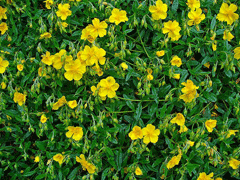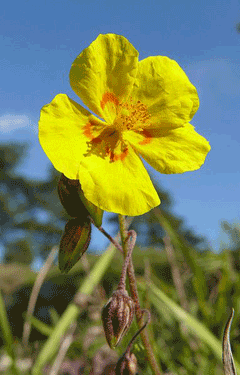 |
|
http://commons.wikimedia.org/wiki/User:Llez |
 |
| http://commons.wikimedia.org/wiki/User:BerndH |
Translate this page:
Summary
Bloom Color: Orange, Pink, Red, White, Yellow. Main Bloom Time: Early summer, Late spring, Mid summer. Form: Spreading or horizontal.
Physical Characteristics

 Helianthemum_nummularium is an evergreen Shrub growing to 0.5 m (1ft 8in) by 1 m (3ft 3in) at a fast rate.
Helianthemum_nummularium is an evergreen Shrub growing to 0.5 m (1ft 8in) by 1 m (3ft 3in) at a fast rate.
See above for USDA hardiness. It is hardy to UK zone 5. It is in leaf all year, in flower from June to September. The species is hermaphrodite (has both male and female organs) and is pollinated by Insects. The plant is self-fertile.
Suitable for: light (sandy), medium (loamy) and heavy (clay) soils. Suitable pH: mildly acid, neutral and basic (mildly alkaline) soils. It can grow in semi-shade (light woodland) or no shade. It prefers moist soil.
UK Hardiness Map
US Hardiness Map
Synonyms
H. chamaecistus. Mill. H. vulgare. Gaertn.
Plant Habitats
Edible Uses
References More on Edible Uses
Medicinal Uses
Plants For A Future can not take any responsibility for any adverse effects from the use of plants. Always seek advice from a professional before using a plant medicinally.
The plant is used in Bach flower remedies - the keywords for prescribing it are 'Terror', 'Panic' and 'Extreme fright'[209]. It is also one of the five ingredients in the 'Rescue remedy'[209].
References More on Medicinal Uses
The Bookshop: Edible Plant Books
Our Latest books on Perennial Plants For Food Forests and Permaculture Gardens in paperback or digital formats.

Edible Tropical Plants
Food Forest Plants for Hotter Conditions: 250+ Plants For Tropical Food Forests & Permaculture Gardens.
More

Edible Temperate Plants
Plants for Your Food Forest: 500 Plants for Temperate Food Forests & Permaculture Gardens.
More

More Books
PFAF have eight books available in paperback and digital formats. Browse the shop for more information.
Shop Now
Other Uses
A prostrate growing plant, it can be used as a ground cover[11].
Special Uses
References More on Other Uses
Cultivation details
Landscape Uses:Alpine garden, Border, Ground cover, Rock garden, Specimen. Requires an open sunny position in a light well-drained soil with a pH between 5.5 and 8[200]. Plants are hardy to at least -10°c[200]. A vigorous plant suitable for the rock garden, crevices in walls or gravel beds[200]. Plants are short-lived, though, soon becoming leggy or sparse, and require fairly frequent replacement[200]. The flowers only open in bright sunshine[200]. Plants resent root disturbance and should be placed in their permanent positions as soon as possible[200]. A polymorphic species[11], there are some named forms that have been selected for their ornamental value[200]. Plants are generally pest and disease-free[200]. Plants in this genus are notably resistant to honey fungus[200]. Special Features:Attractive foliage, Not North American native, Attracts butterflies.
References Carbon Farming Information and Carbon Sequestration Information
Temperature Converter
Type a value in the Celsius field to convert the value to Fahrenheit:
Fahrenheit:
The PFAF Bookshop
Plants For A Future have a number of books available in paperback and digital form. Book titles include Edible Plants, Edible Perennials, Edible Trees,Edible Shrubs, Woodland Gardening, and Temperate Food Forest Plants. Our new book is Food Forest Plants For Hotter Conditions (Tropical and Sub-Tropical).
Shop Now
Plant Propagation
Seed - sow spring in a greenhouse. When they are large enough to handle, prick the seedlings out into individual pots and grow them on in the greenhouse for at least their first winter. Plant them out into their permanent positions in late spring or early summer, after the last expected frosts. Cuttings of half-ripe wood, 6 - 8cm with a heel, late summer in a sandy soil in a frame[200].
Other Names
If available other names are mentioned here
Native Range
TEMPERATE ASIA: Iran, Lebanon, Syria, Turkey, Russian Federation-Ciscaucasia (Ciscaucasia), Armenia, Azerbaijan, Georgia, Russian Federation (Dagestan) EUROPE: Denmark, Finland, United Kingdom, Ireland, Sweden, Czechoslovakia, Switzerland, Germany, Poland, Ukraine (incl. Krym), Former Yugoslavia, Albania, Bulgaria, Greece, Italy (incl. Sardinia), Spain (incl. Baleares), France (incl. Corsica), Portugal
Weed Potential
Right plant wrong place. We are currently updating this section.
Please note that a plant may be invasive in one area but may not in your area so it’s worth checking.
Conservation Status
IUCN Red List of Threatened Plants Status :

Growth: S = slow M = medium F = fast. Soil: L = light (sandy) M = medium H = heavy (clay). pH: A = acid N = neutral B = basic (alkaline). Shade: F = full shade S = semi-shade N = no shade. Moisture: D = dry M = Moist We = wet Wa = water.
Expert comment
Author
(L.)Mill.
Botanical References
1117200
Links / References
For a list of references used on this page please go here
Readers comment
| Add a comment |
|
If you have important information about this plant that may help other users please add a comment or link below. Only comments or links that are felt to be directly relevant to a plant will be included. If you think a comment/link or information contained on this page is inaccurate or misleading we would welcome your feedback at [email protected]. If you have questions about a plant please use the Forum on this website as we do not have the resources to answer questions ourselves.
* Please note: the comments by website users are not necessarily those held by PFAF and may give misleading or inaccurate information.
To leave a comment please Register or login here All comments need to be approved so will not appear immediately.
|
Subject : Helianthemum_nummularium
|
|
|
|